 |
 |
 |
 Tales of Retirement in Paradise Tales of Retirement in Paradise  
Chapter 14: Street Walking in Vallarta
 Polly G. Vicars Polly G. Vicars


| | Abram, ready with fresh juice for the neighborhood in 1994 | 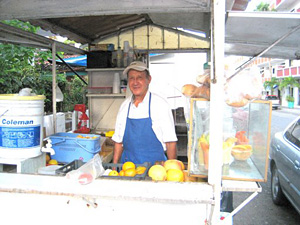
| | Abram still with the ready smile and the best juice in Vallarta 2008 | 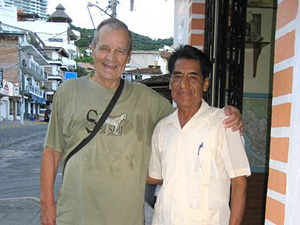
| | Amigos Husband and Vicente, proprietor of Las Huestecas Restaurant 2008 | 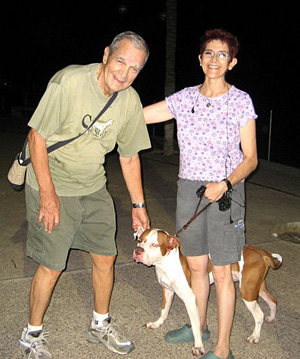
| | Nurse Nora with her great dog Lari greeting Husband 2008 | 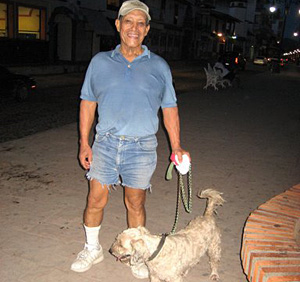
| | Friend Jesus with Canelo 2008 | 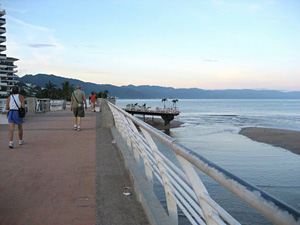
| | The new walking bridge over the Rio Cuale 2008 | 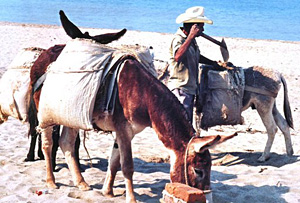
| | The Sand and Gravel Company that has been replaced by the gigantic concrete mixers 1994 | 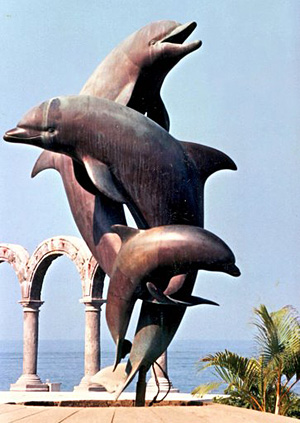
| | The beautiful dolphin fountain in front of the famous arches 1994 | 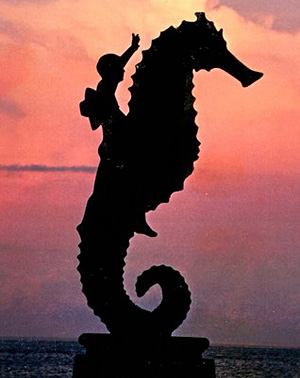
| | The Seahorse, the symbol of Vallarta 1993 | 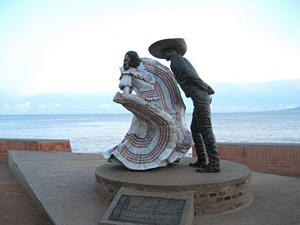
| | Jim Demetro's Folkoric Dancers 2008 | 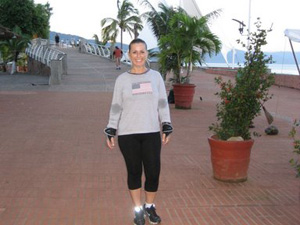
| | The energetic "Chicken Lady" on the Malecón Extended 2008 | 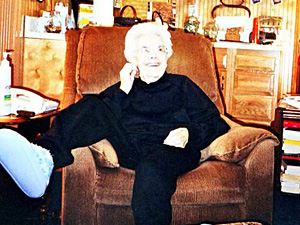
| | Ethel Vicars, mother of Husband |  |
Husband delights in telling people we have enjoyed ten years of absolute wedded bliss before going on to tell them we have been married forty-some years. (Now 57 years.) His humor aside, we try to do everything we can to prolong those years, and we think one way to do that is through exercise - so we walk every day. We start out at 6:15 am. (Husband says that way he gets his exercise in before he even wakes up.) The walk is not solely a bodily exercise, but also an adventure in the culture of México. (We still walk and have even added Pilates and a few hours in a gym.)

We first encounter Abram, the fruit juice vender on the corner. He arrives at his little wooden stand every morning about the time we go by. The days he beats us there, the aroma of fresh squeezed oranges greets us along with his cheery wave and "buenos dias." (Not only is Abram still there, but a real friendship has developed as we have gotten our fresh squeezed orange juice from him all these years.)

Right across the street we hail Vicente, the proprietor of a little Mexican restaurant, Las Tres Hastecas-El Querreque, who has been serving low cost, delicious food to the neighborhood for more than twenty-five years. He is either sweeping the street out front, working on the menu for the day, or, if he is in an unusually happy mood, playing his violin with sweet welcoming notes. (This morning when we stopped to chat with him, I asked to take his picture. He readily agreed, but insisted on having his amigo, Husband, in the picture.)

On to the ice cream parlor where the two handsome teenagers who dish out the ice cream at night are coming out of their home in the back of the shop. They are always carefully dressed in crisp, blue and white school uniforms with their book filled backpacks resting neatly in place. Most mornings our passing coincides with Mamá and Papá bestowing goodbye hugs and kisses on their departing niños. (These girls are now grown and run the little tienda, and always have a cheery wave as we go by.)

Soon we meet the first of our four legged greeters. Bounding in front of his master, taking in the scents of his fellow creatures, is a large, sturdy brown dog of dubious parentage. Even during this morning sprint, he listens carefully for the voice that tells him it's time to heel. His master, known only to us as the "dog man," waves hello to us each morning and voices his "buenos dias" in a hearty voice.

(Unfortunately we haven't seen him a several years, but many "dog people" have taken his place. We greet most of the dogs by name, even though we usually don't know the name of the owner! However in the case of Nora, a magnificent nurse from CMQ who helped bring Husband back to full health a few years ago, we can greet both she and her dog, Lari, by name. We can do the same for Jesus and his faithful companion Canelo who never miss a day.)

As we approach the bridge, (Here is a big change. To cross the Rio Cuale, we now use the new pedestrian bridge that connects Los Muertos Beach to the extended Malecón.) we pause to check the reflecting pool made by the Rio Cuale before it enters into the sea.

If we are lucky, the local sand and gravel company will be there, and we will be rewarded with the reflected images of the stoic burros, standing patiently while their masters fill the ubiquitous burlap bags with beach sand that soon will be incorporated into a tiny home or a magnificent villa. (Lamentably, the sand and gravel men with their burros have been replaced by huge concrete mixers. What a shame!)

At the very least from the bridge, we are afforded a view of the diving ducks, disappearing beneath the water and emerging after what sometimes seems an eternity, enjoying an early morning snack, the graceful garzas (herons), daintily prancing in the shallows, and an occasional fish taking an early morning airing.

Proceeding to the little children's park beside the sea, (this has now been replaced by a large parking garage), we are greeted by the body builder whose stoicism matches that of our burro friends. Every morning he is there with his huge boulder, his version of free weights, lifting and groaning - but always taking time to exchange a few pleasantries with the gringos. (We still see the body builder many mornings, but we now know his name and consider him an old friend.)

Now the contest begins - who will be the first to spot an incoming cruise ship? Will the spot we see on the horizon prove to be a passing sailing yacht or the real thing? During this contest, we are often rewarded with an acrobatic display from the local dolphins, or on special days in the winter, the blow and the sighting of gigantic humpback whales that winter in our bay. In addition, while searching the sea, we are privileged to view the magnificent pelicans in their precise formations swooping down on some unknown signal, searching for today's fishing grounds.

We reach the Malecón, the paved ocean walk that separates the sea from the city and is PV's equivalent to Atlantic City's Boardwalk. We pass the majestic arches and the dancing dolphin fountain, Vallarta landmarks. A little farther down, we salute the last of the statuary symbols, the famed seahorse carrying a young boy on his back. (Many magnificent statues have been added to the beauty of the Malecón, not the least of which are the Colungas, Jim Demetro's Mexican dancers, the Bustamante ladder and three graceful musical mermaids spaced along the walk.)

We salute the patriarch of Vallarta's oldest hotel, The Rosita, majestic in his Stetson hat, walking erect, with the cane used only in cases of unexpected emergencies. His formal and polite greeting never fails to elicit a thirst in me to know more of this man whose vision prompted him to build a hotel in a pueblo that had no electricity, no telephones and no roads leading in. (Sadly, he is no longer walking the Malecón, but is surely supervising from above.)

Then we spot Rocky, the beautiful Doberman who is always joined to his Master by a long rope, bounding, jumping, eyeing the many pigeons that grace the Malecón. We know Rocky by name and never fail to exchange greetings with him and his Master, whose name we don't know. However, we commiserated with him when he had to walk alone for several days while Rocky recovered from a leg injury. (Another who is surely up there watching us.)

From here on, it is a constant procession of friends, most of whom we know only from these daily walks. We get a vivacious "¡Buenos dias! ¿Cómo estan?" from a former First Lady of Vallarta as she fast walks in her stylish jogging suit.

A Vallarta salute and a broad smile bids us good day from Ramón, the local tailor who stays in such excellent physical condition that every year he makes a walking pilgrimage to pay homage to the Virgin of Talpa, a seven-hour drive up into the mountains.

Usually we stop for a minute to get the latest news from our Mexican friend whose American Sea Captain husband died last year and who Husband is helping to untangle the web of papers stringing in from the IRS, Social Security, and the Department of the Navy.

(All are still alive and well, but not walking daily as before.)

As we pass the open-air fresh fish market located less than sixty paces from the source, we check out the morning catch - Red Snapper, Sierra, Grouper, Dorado - and glimpse the old men mending their nets and telling their fish stories.

Leaving the Malecón, we stride on to the back streets of a residential area. There, we are heartily greeted by the chicken lady, a young señora who delivers chickens to Vallarta restaurants. Portraying energy in motion, she sweeps the sidewalk in front of her casa, washes her delivery truck, and wraps and loads the chickens that later in the day will star in enchiladas and fajitas. (I don't think she still sells chickens, she still greets us daily as she whizzes by us.)

From there we are greeted by the neighborhood dogs who know our scent, the women washing down their front walks, the young policeman on his way to work, and the sun rising over the mountains. Soon it is time to turn and begin the trip home.

On the reverse route the greetings are crisper, a quick lift of the hand and adios or hasta mañana serves. By this time our heart rates are up from the exercise, and our hearts are full from the largess and warmth of the friendship passed on to us by our friends, the Vallartenses.

Last summer Husband traveled to Kentucky for three weeks to visit with his eighty-eight-year-young mother, his sisters and brother, and assorted friends and relatives. (I am happy to tell you that we visited all 4 of his siblings in July and they are all alive and well. His Mother is no longer with us, but lived to see her 89th birthday.)

I promised myself I would keep up the regime while he was away, so walked solo every day he was gone. The first day or two no one said anything to me about my lone state, but soon, one after the other stopped me to inquire as to Husband's whereabouts. You could see the smiles of relief on their faces when they found he was away, not ill or worse yet - hadn't run off with some sweet young señorita.

I couldn't believe the inquiries from every Malecón walker - with most of whom we had only this nodding acquaintance. Obviously they felt as we did, that we were real friends. The warmth and empathy they offered left me ready to face each day.

(Same thing happened this week. Husband developed a bad case of bronchitis and we have not walked this week. I went to Rizo's (Husband usually does our grocery shopping, but is under doctor's order to rest for a few more days) and one of the Mexican señoras with whom we only have a morning walk acquaintance saw me and asked why we were not walking! First words other than Buenos Dias we have exchanged after many years of saluting each other!)

Ah! The day Husband returned was fiesta day! Our parade down the Malecón was filled with abrazos (hugs) and shouted greetings and salutes. Again our decision to spend the rest of our lives in this paradise by the sea was affirmed. (After all these years that wonderful feeling that we indeed live in paradise, engulfs us daily. In the next chapter, "It's the People Stupid," you'll hear more about that.)
 Polly G. Vicars and her husband of 57 years, Hubert (a.k.a. "Husband") retired to Puerto Vallarta in 1988 and soon became active members of several charitable organizations. Polly is the author of "Tales of Retirement in Paradise: Life in Puerto Vallarta, Mexico" [a sell-out!] and "More Tales of Retirement in Puerto Vallarta and Around the World." Proceeds from the sale of her books go to the America-Mexico Foundation, a scholarship foundation that is their passion. Polly G. Vicars and her husband of 57 years, Hubert (a.k.a. "Husband") retired to Puerto Vallarta in 1988 and soon became active members of several charitable organizations. Polly is the author of "Tales of Retirement in Paradise: Life in Puerto Vallarta, Mexico" [a sell-out!] and "More Tales of Retirement in Puerto Vallarta and Around the World." Proceeds from the sale of her books go to the America-Mexico Foundation, a scholarship foundation that is their passion.

Click HERE for more articles by Polly Vicars. | 
 | |
 |



